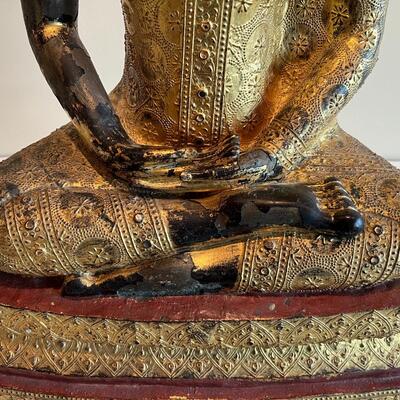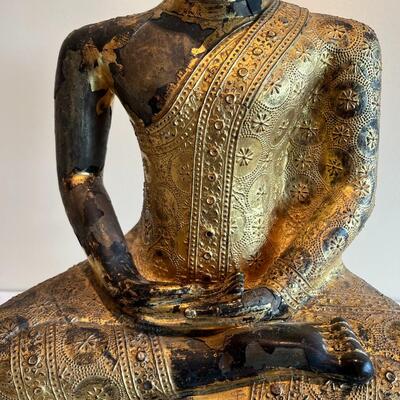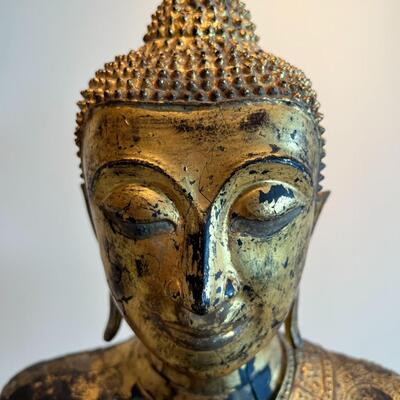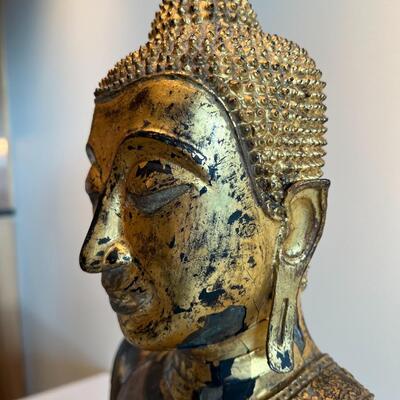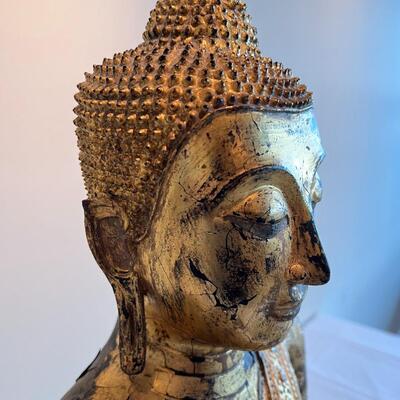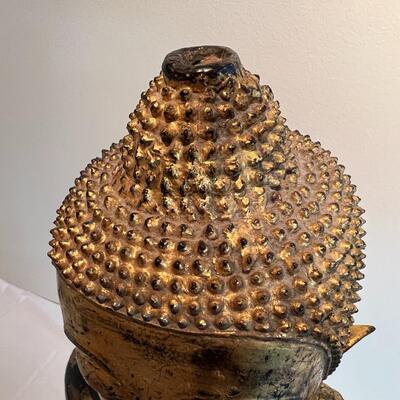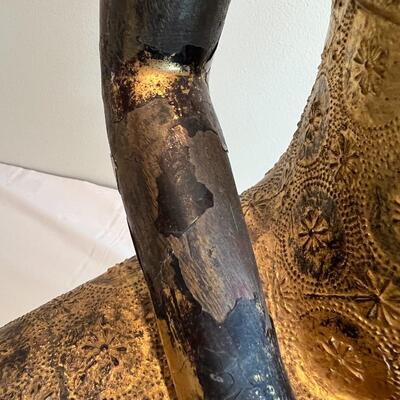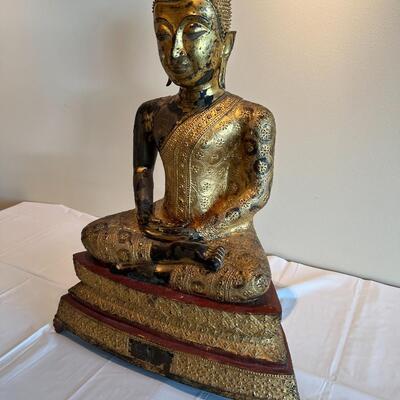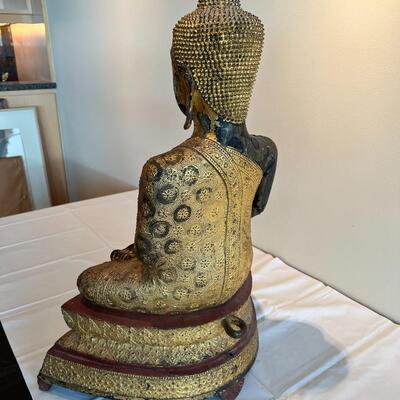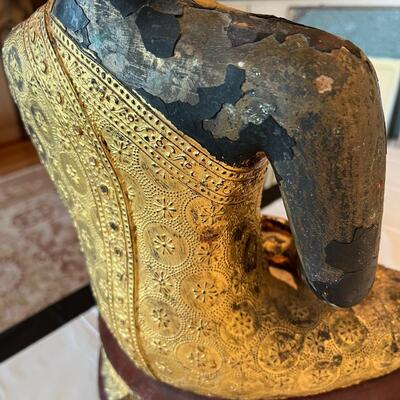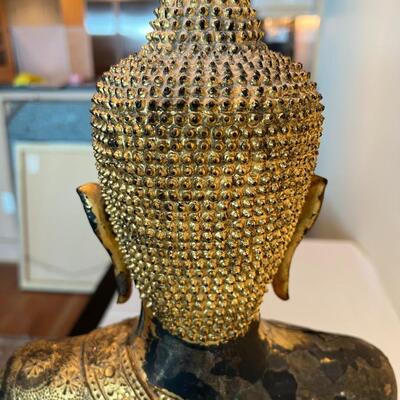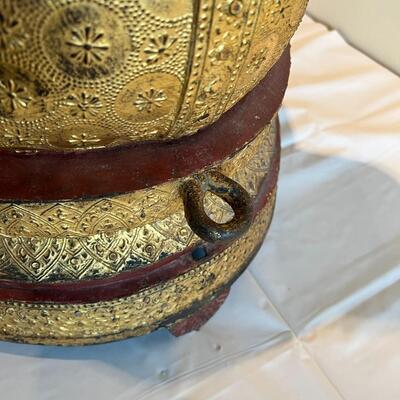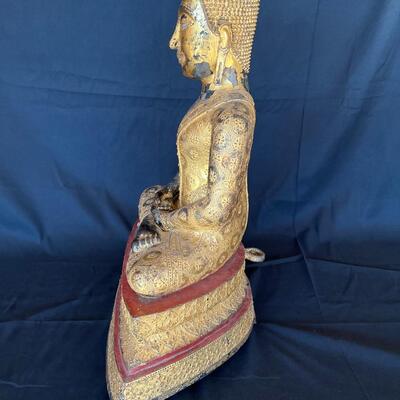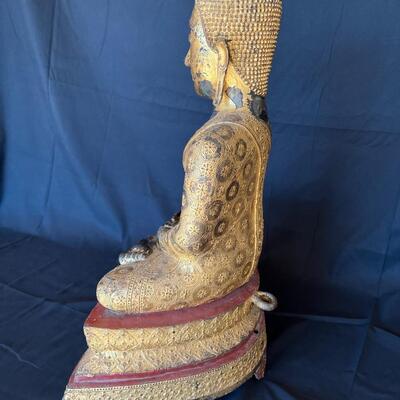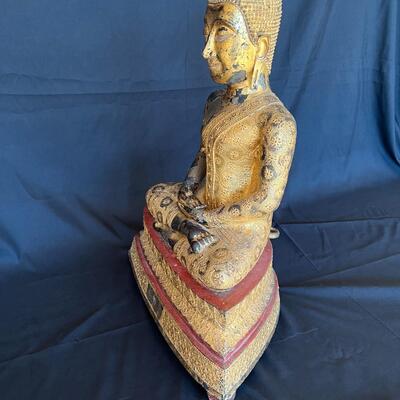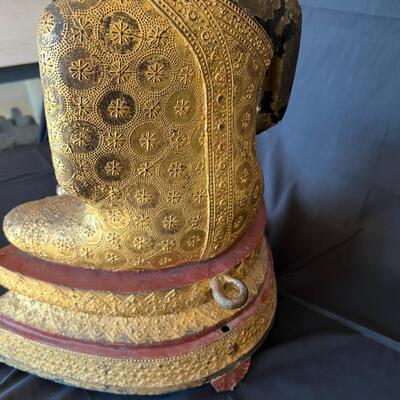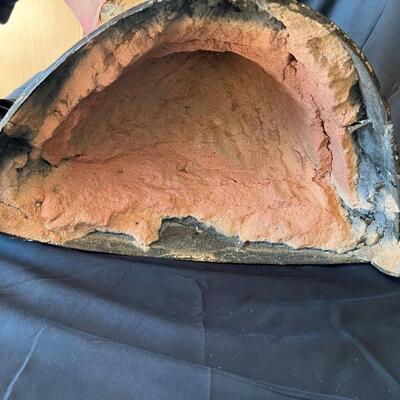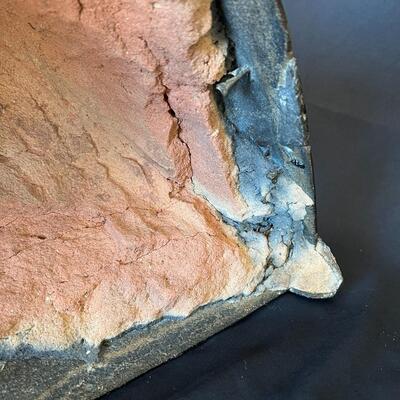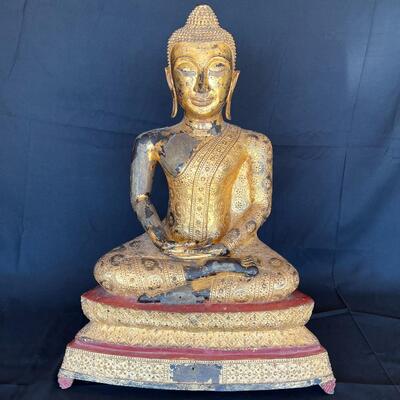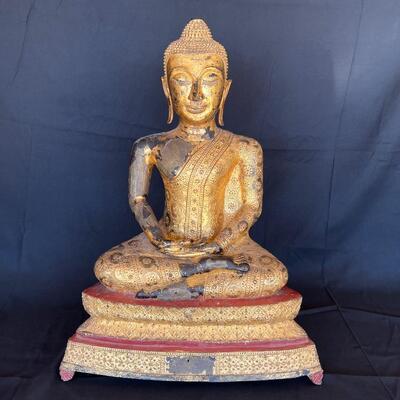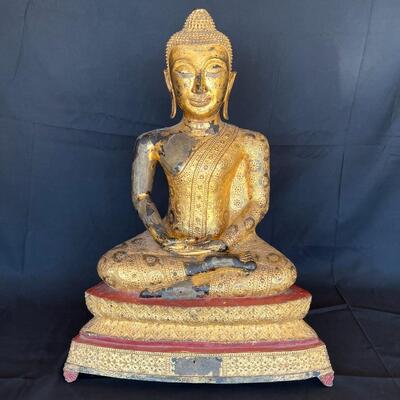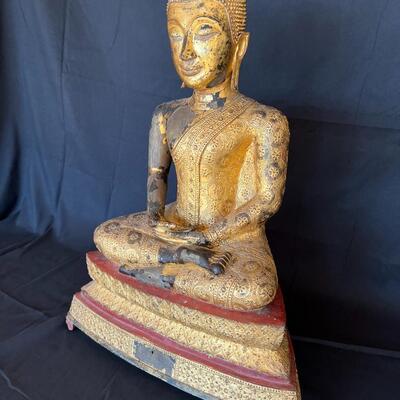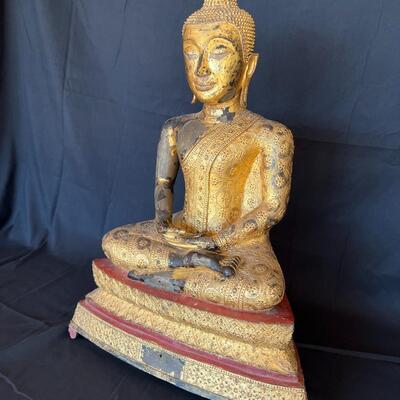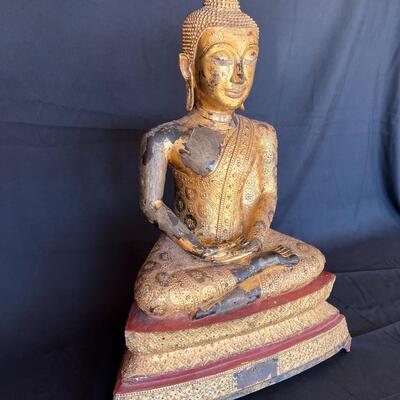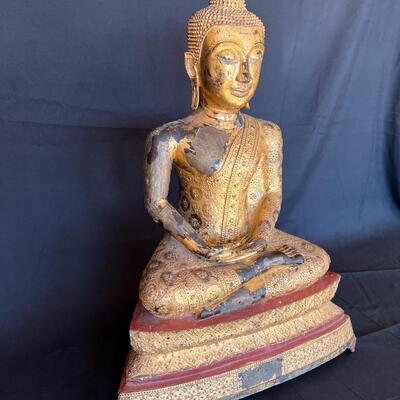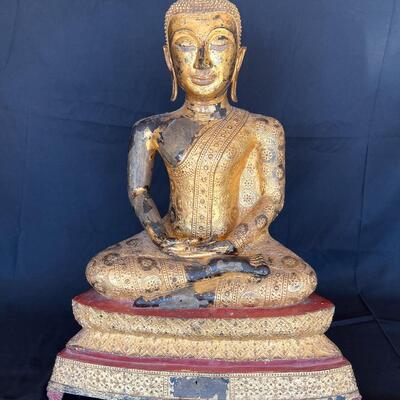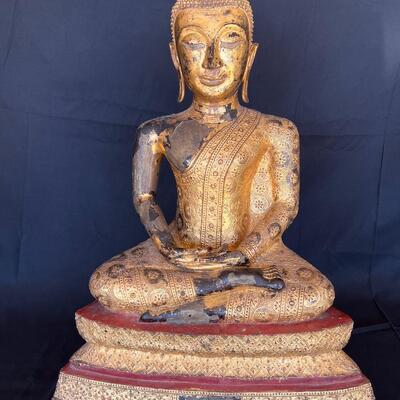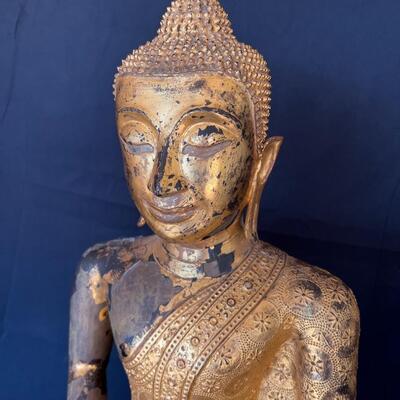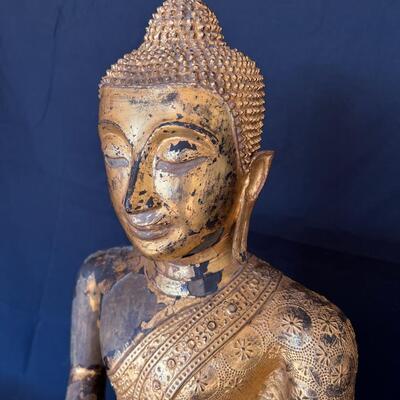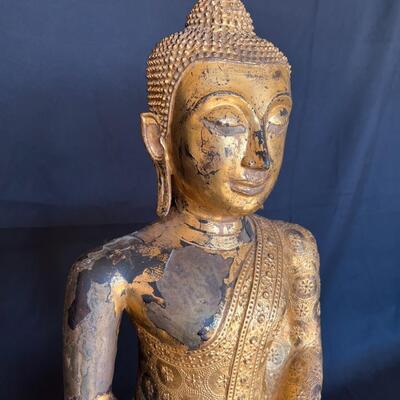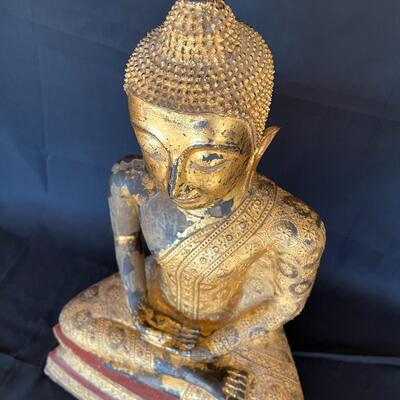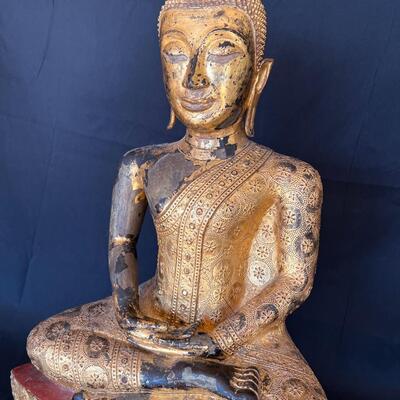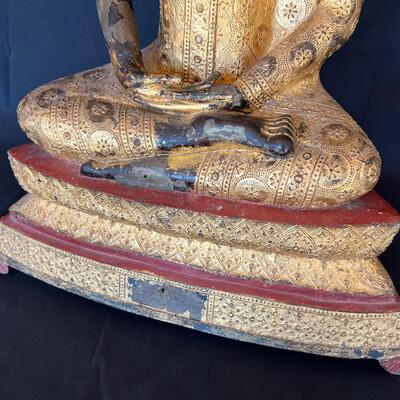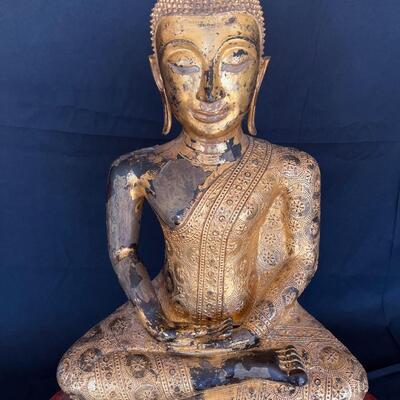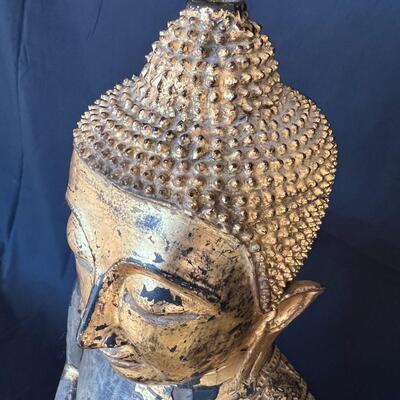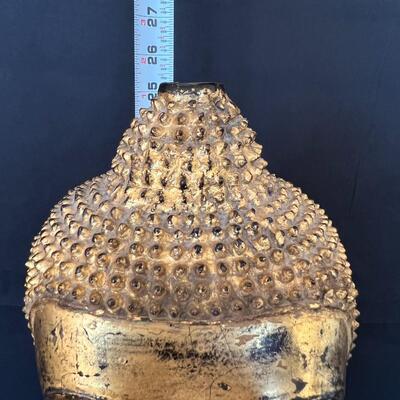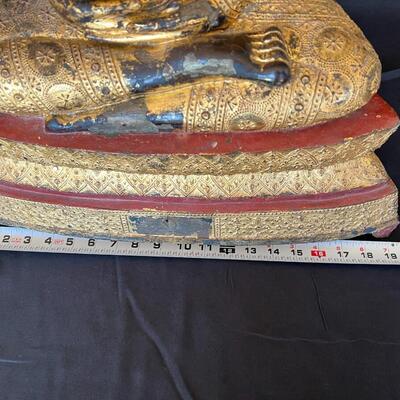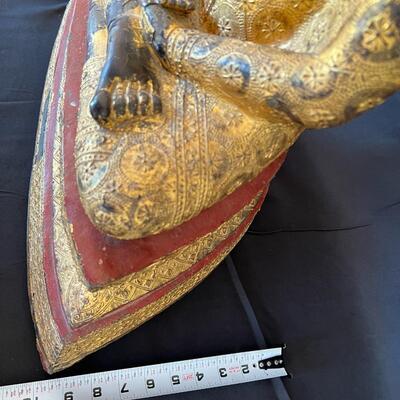-
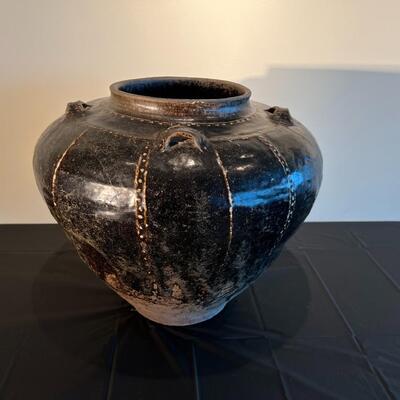
Beautiful antique glazed pot from Burma circa late 16th or early 17th century. Known in antique circles as a "Martaban Jar" or "Myanmar Jar," this exquisite example of pottery is a sought-after style and time period for any Asian art collector. Martaban pottery in particular was known for being some of the largest and sturdiest of the 16th century, using very large kilns to make jars like this one. A very rare find, especially at this level of quality and design detail. A dark brown almost black glaze on top, with four equivalently spaced handles and a dotted design that is known for this region and time period. In very good condition, as shown (photographed under natural and indoor lights, against multiple backgrounds, to show the color patina of the glaze as accurately as possible). Provenance from the estate indicates that this antique Burmese pot dates to circa 1600. 143 / 901 -
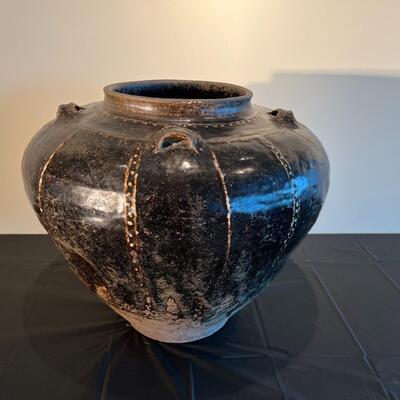
Beautiful antique glazed pot from Burma circa late 16th or early 17th century. Known in antique circles as a "Martaban Jar" or "Myanmar Jar," this exquisite example of pottery is a sought-after style and time period for any Asian art collector. Martaban pottery in particular was known for being some of the largest and sturdiest of the 16th century, using very large kilns to make jars like this one. A very rare find, especially at this level of quality and design detail. A dark brown almost black glaze on top, with four equivalently spaced handles and a dotted design that is known for this region and time period. In very good condition, as shown (photographed under natural and indoor lights, against multiple backgrounds, to show the color patina of the glaze as accurately as possible). Provenance from the estate indicates that this antique Burmese pot dates to circa 1600. 144 / 901 -
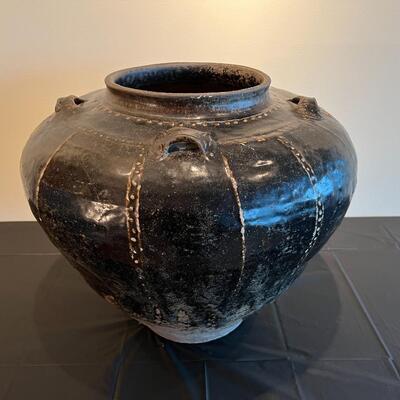
Beautiful antique glazed pot from Burma circa late 16th or early 17th century. Known in antique circles as a "Martaban Jar" or "Myanmar Jar," this exquisite example of pottery is a sought-after style and time period for any Asian art collector. Martaban pottery in particular was known for being some of the largest and sturdiest of the 16th century, using very large kilns to make jars like this one. A very rare find, especially at this level of quality and design detail. A dark brown almost black glaze on top, with four equivalently spaced handles and a dotted design that is known for this region and time period. In very good condition, as shown (photographed under natural and indoor lights, against multiple backgrounds, to show the color patina of the glaze as accurately as possible). Provenance from the estate indicates that this antique Burmese pot dates to circa 1600. 145 / 901 -
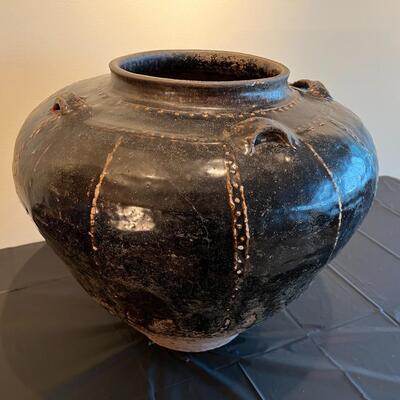
Beautiful antique glazed pot from Burma circa late 16th or early 17th century. Known in antique circles as a "Martaban Jar" or "Myanmar Jar," this exquisite example of pottery is a sought-after style and time period for any Asian art collector. Martaban pottery in particular was known for being some of the largest and sturdiest of the 16th century, using very large kilns to make jars like this one. A very rare find, especially at this level of quality and design detail. A dark brown almost black glaze on top, with four equivalently spaced handles and a dotted design that is known for this region and time period. In very good condition, as shown (photographed under natural and indoor lights, against multiple backgrounds, to show the color patina of the glaze as accurately as possible). Provenance from the estate indicates that this antique Burmese pot dates to circa 1600. 146 / 901 -
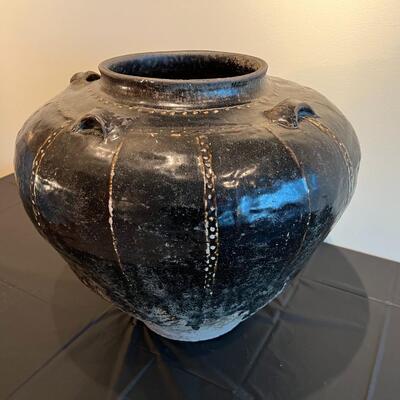
Beautiful antique glazed pot from Burma circa late 16th or early 17th century. Known in antique circles as a "Martaban Jar" or "Myanmar Jar," this exquisite example of pottery is a sought-after style and time period for any Asian art collector. Martaban pottery in particular was known for being some of the largest and sturdiest of the 16th century, using very large kilns to make jars like this one. A very rare find, especially at this level of quality and design detail. A dark brown almost black glaze on top, with four equivalently spaced handles and a dotted design that is known for this region and time period. In very good condition, as shown (photographed under natural and indoor lights, against multiple backgrounds, to show the color patina of the glaze as accurately as possible). Provenance from the estate indicates that this antique Burmese pot dates to circa 1600. 147 / 901 -
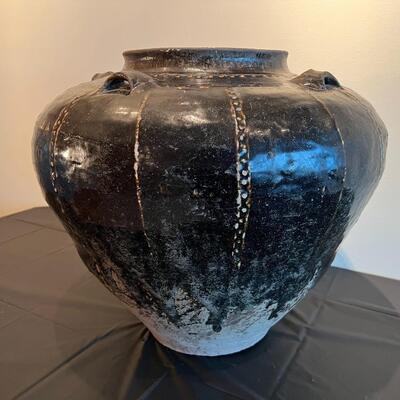
Beautiful antique glazed pot from Burma circa late 16th or early 17th century. Known in antique circles as a "Martaban Jar" or "Myanmar Jar," this exquisite example of pottery is a sought-after style and time period for any Asian art collector. Martaban pottery in particular was known for being some of the largest and sturdiest of the 16th century, using very large kilns to make jars like this one. A very rare find, especially at this level of quality and design detail. A dark brown almost black glaze on top, with four equivalently spaced handles and a dotted design that is known for this region and time period. In very good condition, as shown (photographed under natural and indoor lights, against multiple backgrounds, to show the color patina of the glaze as accurately as possible). Provenance from the estate indicates that this antique Burmese pot dates to circa 1600. 148 / 901 -
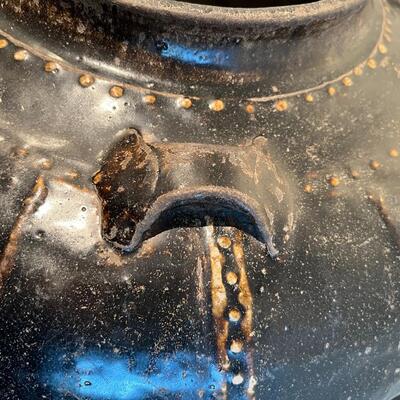
Beautiful antique glazed pot from Burma circa late 16th or early 17th century. Known in antique circles as a "Martaban Jar" or "Myanmar Jar," this exquisite example of pottery is a sought-after style and time period for any Asian art collector. Martaban pottery in particular was known for being some of the largest and sturdiest of the 16th century, using very large kilns to make jars like this one. A very rare find, especially at this level of quality and design detail. A dark brown almost black glaze on top, with four equivalently spaced handles and a dotted design that is known for this region and time period. In very good condition, as shown (photographed under natural and indoor lights, against multiple backgrounds, to show the color patina of the glaze as accurately as possible). Provenance from the estate indicates that this antique Burmese pot dates to circa 1600. 149 / 901 -
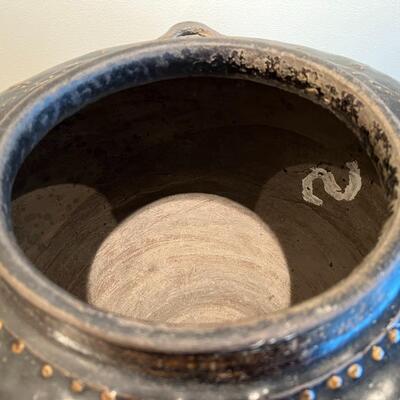
Beautiful antique glazed pot from Burma circa late 16th or early 17th century. Known in antique circles as a "Martaban Jar" or "Myanmar Jar," this exquisite example of pottery is a sought-after style and time period for any Asian art collector. Martaban pottery in particular was known for being some of the largest and sturdiest of the 16th century, using very large kilns to make jars like this one. A very rare find, especially at this level of quality and design detail. A dark brown almost black glaze on top, with four equivalently spaced handles and a dotted design that is known for this region and time period. In very good condition, as shown (photographed under natural and indoor lights, against multiple backgrounds, to show the color patina of the glaze as accurately as possible). Provenance from the estate indicates that this antique Burmese pot dates to circa 1600. 150 / 901 -
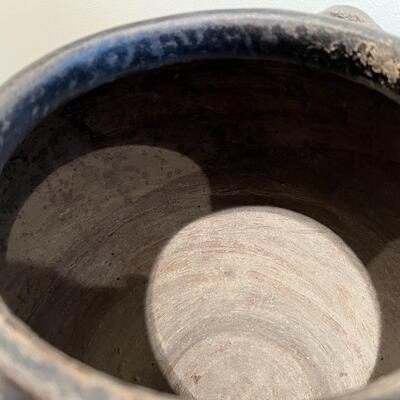
Beautiful antique glazed pot from Burma circa late 16th or early 17th century. Known in antique circles as a "Martaban Jar" or "Myanmar Jar," this exquisite example of pottery is a sought-after style and time period for any Asian art collector. Martaban pottery in particular was known for being some of the largest and sturdiest of the 16th century, using very large kilns to make jars like this one. A very rare find, especially at this level of quality and design detail. A dark brown almost black glaze on top, with four equivalently spaced handles and a dotted design that is known for this region and time period. In very good condition, as shown (photographed under natural and indoor lights, against multiple backgrounds, to show the color patina of the glaze as accurately as possible). Provenance from the estate indicates that this antique Burmese pot dates to circa 1600. 151 / 901 -
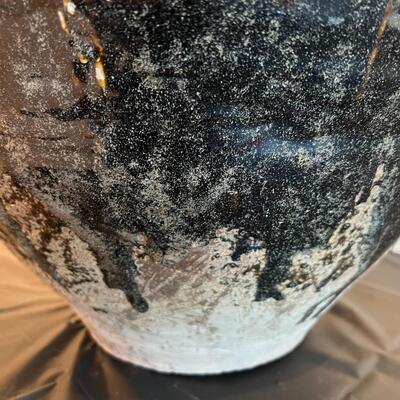
Beautiful antique glazed pot from Burma circa late 16th or early 17th century. Known in antique circles as a "Martaban Jar" or "Myanmar Jar," this exquisite example of pottery is a sought-after style and time period for any Asian art collector. Martaban pottery in particular was known for being some of the largest and sturdiest of the 16th century, using very large kilns to make jars like this one. A very rare find, especially at this level of quality and design detail. A dark brown almost black glaze on top, with four equivalently spaced handles and a dotted design that is known for this region and time period. In very good condition, as shown (photographed under natural and indoor lights, against multiple backgrounds, to show the color patina of the glaze as accurately as possible). Provenance from the estate indicates that this antique Burmese pot dates to circa 1600. 152 / 901 -
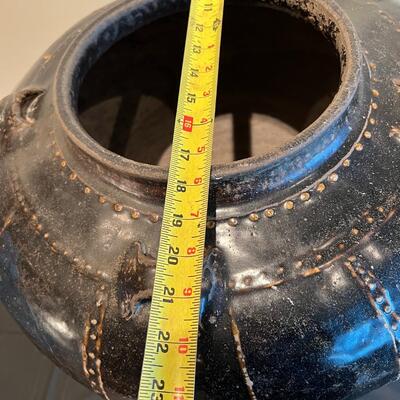
Beautiful antique glazed pot from Burma circa late 16th or early 17th century. Known in antique circles as a "Martaban Jar" or "Myanmar Jar," this exquisite example of pottery is a sought-after style and time period for any Asian art collector. Martaban pottery in particular was known for being some of the largest and sturdiest of the 16th century, using very large kilns to make jars like this one. A very rare find, especially at this level of quality and design detail. A dark brown almost black glaze on top, with four equivalently spaced handles and a dotted design that is known for this region and time period. In very good condition, as shown (photographed under natural and indoor lights, against multiple backgrounds, to show the color patina of the glaze as accurately as possible). Provenance from the estate indicates that this antique Burmese pot dates to circa 1600. 153 / 901 -
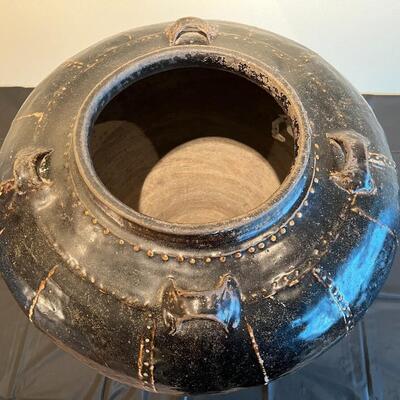
Beautiful antique glazed pot from Burma circa late 16th or early 17th century. Known in antique circles as a "Martaban Jar" or "Myanmar Jar," this exquisite example of pottery is a sought-after style and time period for any Asian art collector. Martaban pottery in particular was known for being some of the largest and sturdiest of the 16th century, using very large kilns to make jars like this one. A very rare find, especially at this level of quality and design detail. A dark brown almost black glaze on top, with four equivalently spaced handles and a dotted design that is known for this region and time period. In very good condition, as shown (photographed under natural and indoor lights, against multiple backgrounds, to show the color patina of the glaze as accurately as possible). Provenance from the estate indicates that this antique Burmese pot dates to circa 1600. 154 / 901 -
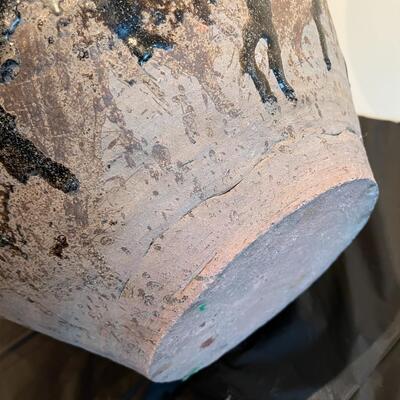
Beautiful antique glazed pot from Burma circa late 16th or early 17th century. Known in antique circles as a "Martaban Jar" or "Myanmar Jar," this exquisite example of pottery is a sought-after style and time period for any Asian art collector. Martaban pottery in particular was known for being some of the largest and sturdiest of the 16th century, using very large kilns to make jars like this one. A very rare find, especially at this level of quality and design detail. A dark brown almost black glaze on top, with four equivalently spaced handles and a dotted design that is known for this region and time period. In very good condition, as shown (photographed under natural and indoor lights, against multiple backgrounds, to show the color patina of the glaze as accurately as possible). Provenance from the estate indicates that this antique Burmese pot dates to circa 1600. 155 / 901 -
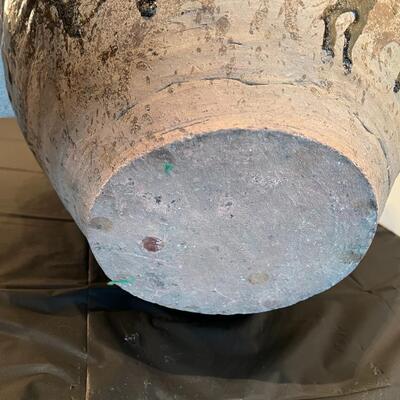
Beautiful antique glazed pot from Burma circa late 16th or early 17th century. Known in antique circles as a "Martaban Jar" or "Myanmar Jar," this exquisite example of pottery is a sought-after style and time period for any Asian art collector. Martaban pottery in particular was known for being some of the largest and sturdiest of the 16th century, using very large kilns to make jars like this one. A very rare find, especially at this level of quality and design detail. A dark brown almost black glaze on top, with four equivalently spaced handles and a dotted design that is known for this region and time period. In very good condition, as shown (photographed under natural and indoor lights, against multiple backgrounds, to show the color patina of the glaze as accurately as possible). Provenance from the estate indicates that this antique Burmese pot dates to circa 1600. 156 / 901 -
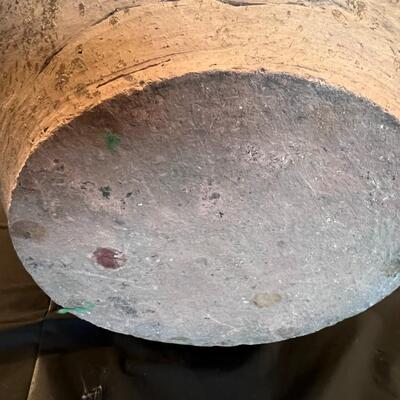
Beautiful antique glazed pot from Burma circa late 16th or early 17th century. Known in antique circles as a "Martaban Jar" or "Myanmar Jar," this exquisite example of pottery is a sought-after style and time period for any Asian art collector. Martaban pottery in particular was known for being some of the largest and sturdiest of the 16th century, using very large kilns to make jars like this one. A very rare find, especially at this level of quality and design detail. A dark brown almost black glaze on top, with four equivalently spaced handles and a dotted design that is known for this region and time period. In very good condition, as shown (photographed under natural and indoor lights, against multiple backgrounds, to show the color patina of the glaze as accurately as possible). Provenance from the estate indicates that this antique Burmese pot dates to circa 1600. 157 / 901 -
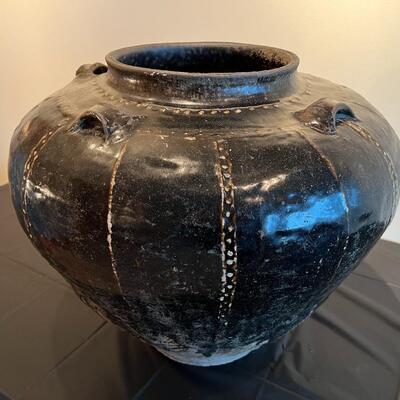
Beautiful antique glazed pot from Burma circa late 16th or early 17th century. Known in antique circles as a "Martaban Jar" or "Myanmar Jar," this exquisite example of pottery is a sought-after style and time period for any Asian art collector. Martaban pottery in particular was known for being some of the largest and sturdiest of the 16th century, using very large kilns to make jars like this one. A very rare find, especially at this level of quality and design detail. A dark brown almost black glaze on top, with four equivalently spaced handles and a dotted design that is known for this region and time period. In very good condition, as shown (photographed under natural and indoor lights, against multiple backgrounds, to show the color patina of the glaze as accurately as possible). Provenance from the estate indicates that this antique Burmese pot dates to circa 1600. 158 / 901 -
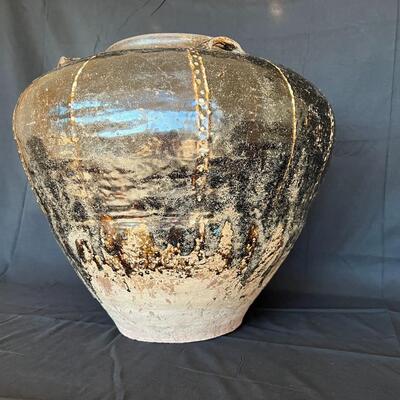
Beautiful antique glazed pot from Burma circa late 16th or early 17th century. Known in antique circles as a "Martaban Jar" or "Myanmar Jar," this exquisite example of pottery is a sought-after style and time period for any Asian art collector. Martaban pottery in particular was known for being some of the largest and sturdiest of the 16th century, using very large kilns to make jars like this one. A very rare find, especially at this level of quality and design detail. A dark brown almost black glaze on top, with four equivalently spaced handles and a dotted design that is known for this region and time period. In very good condition, as shown (photographed under natural and indoor lights, against multiple backgrounds, to show the color patina of the glaze as accurately as possible). Provenance from the estate indicates that this antique Burmese pot dates to circa 1600. 159 / 901 -
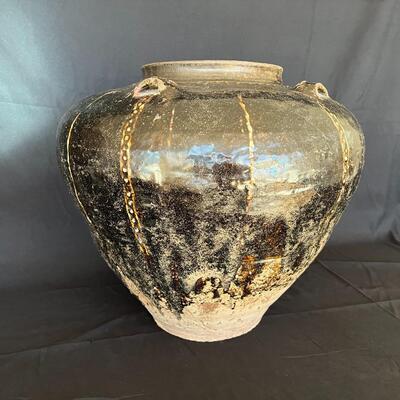
Beautiful antique glazed pot from Burma circa late 16th or early 17th century. Known in antique circles as a "Martaban Jar" or "Myanmar Jar," this exquisite example of pottery is a sought-after style and time period for any Asian art collector. Martaban pottery in particular was known for being some of the largest and sturdiest of the 16th century, using very large kilns to make jars like this one. A very rare find, especially at this level of quality and design detail. A dark brown almost black glaze on top, with four equivalently spaced handles and a dotted design that is known for this region and time period. In very good condition, as shown (photographed under natural and indoor lights, against multiple backgrounds, to show the color patina of the glaze as accurately as possible). Provenance from the estate indicates that this antique Burmese pot dates to circa 1600. 160 / 901 -
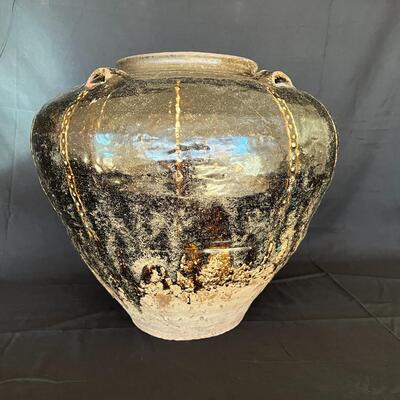
Beautiful antique glazed pot from Burma circa late 16th or early 17th century. Known in antique circles as a "Martaban Jar" or "Myanmar Jar," this exquisite example of pottery is a sought-after style and time period for any Asian art collector. Martaban pottery in particular was known for being some of the largest and sturdiest of the 16th century, using very large kilns to make jars like this one. A very rare find, especially at this level of quality and design detail. A dark brown almost black glaze on top, with four equivalently spaced handles and a dotted design that is known for this region and time period. In very good condition, as shown (photographed under natural and indoor lights, against multiple backgrounds, to show the color patina of the glaze as accurately as possible). Provenance from the estate indicates that this antique Burmese pot dates to circa 1600. 161 / 901 -
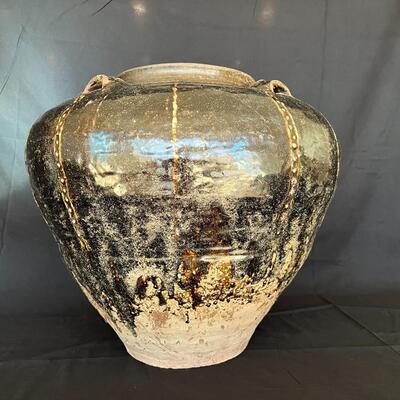
Beautiful antique glazed pot from Burma circa late 16th or early 17th century. Known in antique circles as a "Martaban Jar" or "Myanmar Jar," this exquisite example of pottery is a sought-after style and time period for any Asian art collector. Martaban pottery in particular was known for being some of the largest and sturdiest of the 16th century, using very large kilns to make jars like this one. A very rare find, especially at this level of quality and design detail. A dark brown almost black glaze on top, with four equivalently spaced handles and a dotted design that is known for this region and time period. In very good condition, as shown (photographed under natural and indoor lights, against multiple backgrounds, to show the color patina of the glaze as accurately as possible). Provenance from the estate indicates that this antique Burmese pot dates to circa 1600. 162 / 901 -
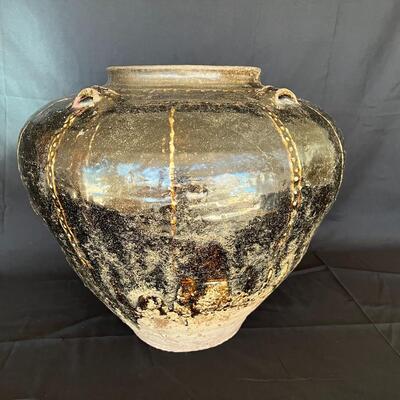
Beautiful antique glazed pot from Burma circa late 16th or early 17th century. Known in antique circles as a "Martaban Jar" or "Myanmar Jar," this exquisite example of pottery is a sought-after style and time period for any Asian art collector. Martaban pottery in particular was known for being some of the largest and sturdiest of the 16th century, using very large kilns to make jars like this one. A very rare find, especially at this level of quality and design detail. A dark brown almost black glaze on top, with four equivalently spaced handles and a dotted design that is known for this region and time period. In very good condition, as shown (photographed under natural and indoor lights, against multiple backgrounds, to show the color patina of the glaze as accurately as possible). Provenance from the estate indicates that this antique Burmese pot dates to circa 1600. 163 / 901 -
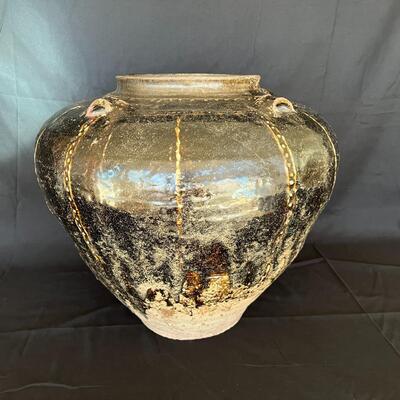
Beautiful antique glazed pot from Burma circa late 16th or early 17th century. Known in antique circles as a "Martaban Jar" or "Myanmar Jar," this exquisite example of pottery is a sought-after style and time period for any Asian art collector. Martaban pottery in particular was known for being some of the largest and sturdiest of the 16th century, using very large kilns to make jars like this one. A very rare find, especially at this level of quality and design detail. A dark brown almost black glaze on top, with four equivalently spaced handles and a dotted design that is known for this region and time period. In very good condition, as shown (photographed under natural and indoor lights, against multiple backgrounds, to show the color patina of the glaze as accurately as possible). Provenance from the estate indicates that this antique Burmese pot dates to circa 1600. 164 / 901 -
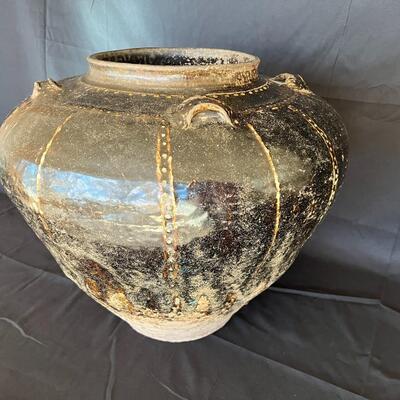
Beautiful antique glazed pot from Burma circa late 16th or early 17th century. Known in antique circles as a "Martaban Jar" or "Myanmar Jar," this exquisite example of pottery is a sought-after style and time period for any Asian art collector. Martaban pottery in particular was known for being some of the largest and sturdiest of the 16th century, using very large kilns to make jars like this one. A very rare find, especially at this level of quality and design detail. A dark brown almost black glaze on top, with four equivalently spaced handles and a dotted design that is known for this region and time period. In very good condition, as shown (photographed under natural and indoor lights, against multiple backgrounds, to show the color patina of the glaze as accurately as possible). Provenance from the estate indicates that this antique Burmese pot dates to circa 1600. 165 / 901 -
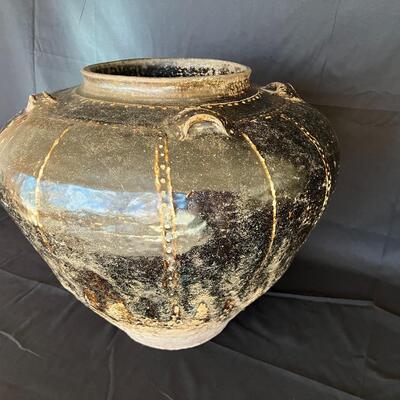
Beautiful antique glazed pot from Burma circa late 16th or early 17th century. Known in antique circles as a "Martaban Jar" or "Myanmar Jar," this exquisite example of pottery is a sought-after style and time period for any Asian art collector. Martaban pottery in particular was known for being some of the largest and sturdiest of the 16th century, using very large kilns to make jars like this one. A very rare find, especially at this level of quality and design detail. A dark brown almost black glaze on top, with four equivalently spaced handles and a dotted design that is known for this region and time period. In very good condition, as shown (photographed under natural and indoor lights, against multiple backgrounds, to show the color patina of the glaze as accurately as possible). Provenance from the estate indicates that this antique Burmese pot dates to circa 1600. 166 / 901 -
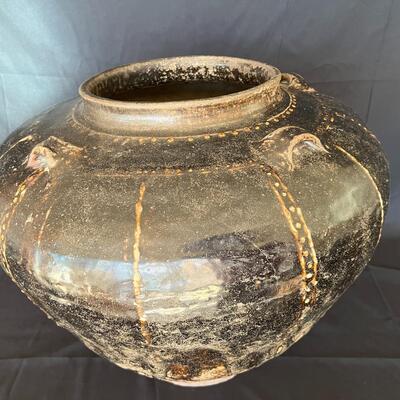
Beautiful antique glazed pot from Burma circa late 16th or early 17th century. Known in antique circles as a "Martaban Jar" or "Myanmar Jar," this exquisite example of pottery is a sought-after style and time period for any Asian art collector. Martaban pottery in particular was known for being some of the largest and sturdiest of the 16th century, using very large kilns to make jars like this one. A very rare find, especially at this level of quality and design detail. A dark brown almost black glaze on top, with four equivalently spaced handles and a dotted design that is known for this region and time period. In very good condition, as shown (photographed under natural and indoor lights, against multiple backgrounds, to show the color patina of the glaze as accurately as possible). Provenance from the estate indicates that this antique Burmese pot dates to circa 1600. 167 / 901 -
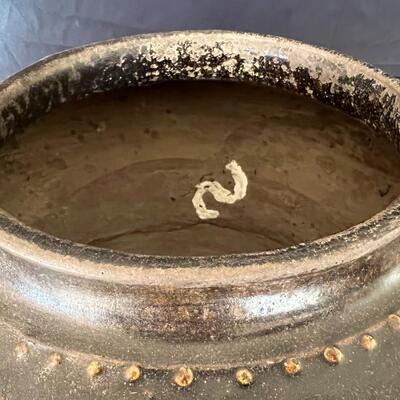
Beautiful antique glazed pot from Burma circa late 16th or early 17th century. Known in antique circles as a "Martaban Jar" or "Myanmar Jar," this exquisite example of pottery is a sought-after style and time period for any Asian art collector. Martaban pottery in particular was known for being some of the largest and sturdiest of the 16th century, using very large kilns to make jars like this one. A very rare find, especially at this level of quality and design detail. A dark brown almost black glaze on top, with four equivalently spaced handles and a dotted design that is known for this region and time period. In very good condition, as shown (photographed under natural and indoor lights, against multiple backgrounds, to show the color patina of the glaze as accurately as possible). Provenance from the estate indicates that this antique Burmese pot dates to circa 1600. 168 / 901 -
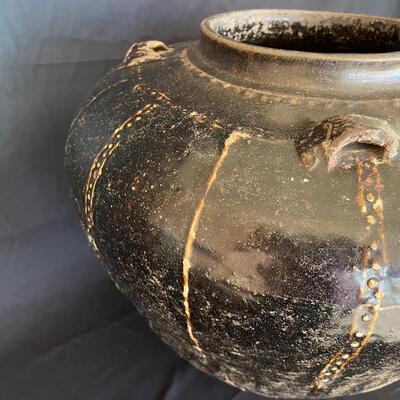
Beautiful antique glazed pot from Burma circa late 16th or early 17th century. Known in antique circles as a "Martaban Jar" or "Myanmar Jar," this exquisite example of pottery is a sought-after style and time period for any Asian art collector. Martaban pottery in particular was known for being some of the largest and sturdiest of the 16th century, using very large kilns to make jars like this one. A very rare find, especially at this level of quality and design detail. A dark brown almost black glaze on top, with four equivalently spaced handles and a dotted design that is known for this region and time period. In very good condition, as shown (photographed under natural and indoor lights, against multiple backgrounds, to show the color patina of the glaze as accurately as possible). Provenance from the estate indicates that this antique Burmese pot dates to circa 1600. 169 / 901 -
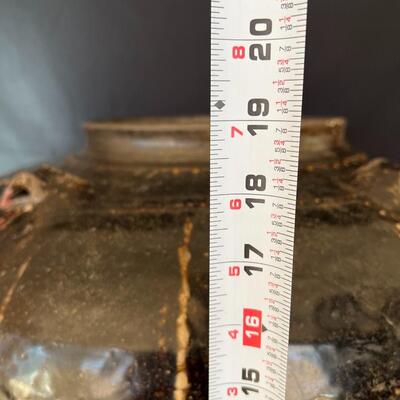
Beautiful antique glazed pot from Burma circa late 16th or early 17th century. Known in antique circles as a "Martaban Jar" or "Myanmar Jar," this exquisite example of pottery is a sought-after style and time period for any Asian art collector. Martaban pottery in particular was known for being some of the largest and sturdiest of the 16th century, using very large kilns to make jars like this one. A very rare find, especially at this level of quality and design detail. A dark brown almost black glaze on top, with four equivalently spaced handles and a dotted design that is known for this region and time period. In very good condition, as shown (photographed under natural and indoor lights, against multiple backgrounds, to show the color patina of the glaze as accurately as possible). Provenance from the estate indicates that this antique Burmese pot dates to circa 1600. 170 / 901 -
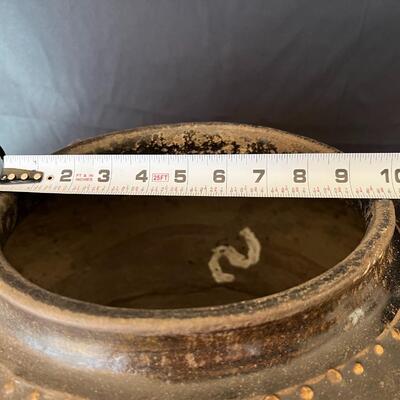
Beautiful antique glazed pot from Burma circa late 16th or early 17th century. Known in antique circles as a "Martaban Jar" or "Myanmar Jar," this exquisite example of pottery is a sought-after style and time period for any Asian art collector. Martaban pottery in particular was known for being some of the largest and sturdiest of the 16th century, using very large kilns to make jars like this one. A very rare find, especially at this level of quality and design detail. A dark brown almost black glaze on top, with four equivalently spaced handles and a dotted design that is known for this region and time period. In very good condition, as shown (photographed under natural and indoor lights, against multiple backgrounds, to show the color patina of the glaze as accurately as possible). Provenance from the estate indicates that this antique Burmese pot dates to circa 1600. 171 / 901 -
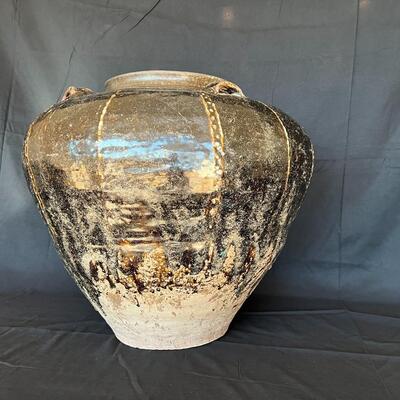
Beautiful antique glazed pot from Burma circa late 16th or early 17th century. Known in antique circles as a "Martaban Jar" or "Myanmar Jar," this exquisite example of pottery is a sought-after style and time period for any Asian art collector. Martaban pottery in particular was known for being some of the largest and sturdiest of the 16th century, using very large kilns to make jars like this one. A very rare find, especially at this level of quality and design detail. A dark brown almost black glaze on top, with four equivalently spaced handles and a dotted design that is known for this region and time period. In very good condition, as shown (photographed under natural and indoor lights, against multiple backgrounds, to show the color patina of the glaze as accurately as possible). Provenance from the estate indicates that this antique Burmese pot dates to circa 1600. 172 / 901 -
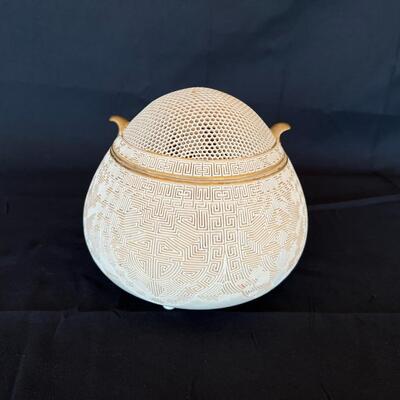
Very rare and extraordinarily intricate design on this Japanese satsuma incense burner. Stamped by maker. Lid features a honeycomb reticulated double wall design (very high levels of craftsmanship). Gilt gold painted on edges of lid and small handles. This piece was evaluated in 1992 by Honeychurch Antiques gallery in Seattle, WA to be very rare piece of extremely fine design, and attributed to the Meiji Period circa 1880. In very good condition. 173 / 901 sold -
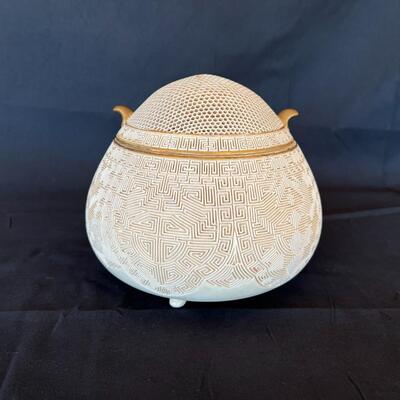
Very rare and extraordinarily intricate design on this Japanese satsuma incense burner. Stamped by maker. Lid features a honeycomb reticulated double wall design (very high levels of craftsmanship). Gilt gold painted on edges of lid and small handles. This piece was evaluated in 1992 by Honeychurch Antiques gallery in Seattle, WA to be very rare piece of extremely fine design, and attributed to the Meiji Period circa 1880. In very good condition. 174 / 901 sold -
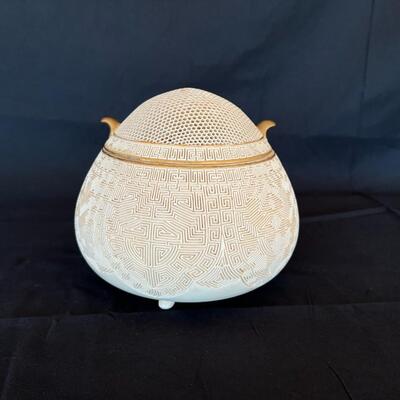
Very rare and extraordinarily intricate design on this Japanese satsuma incense burner. Stamped by maker. Lid features a honeycomb reticulated double wall design (very high levels of craftsmanship). Gilt gold painted on edges of lid and small handles. This piece was evaluated in 1992 by Honeychurch Antiques gallery in Seattle, WA to be very rare piece of extremely fine design, and attributed to the Meiji Period circa 1880. In very good condition. 175 / 901 sold -
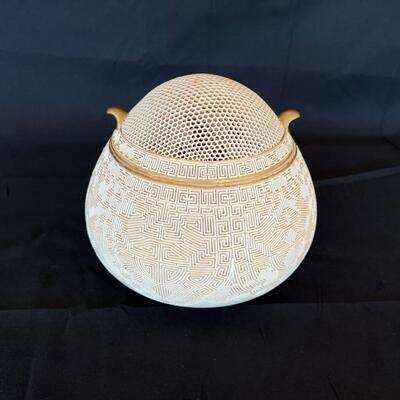
Very rare and extraordinarily intricate design on this Japanese satsuma incense burner. Stamped by maker. Lid features a honeycomb reticulated double wall design (very high levels of craftsmanship). Gilt gold painted on edges of lid and small handles. This piece was evaluated in 1992 by Honeychurch Antiques gallery in Seattle, WA to be very rare piece of extremely fine design, and attributed to the Meiji Period circa 1880. In very good condition. 176 / 901 sold -
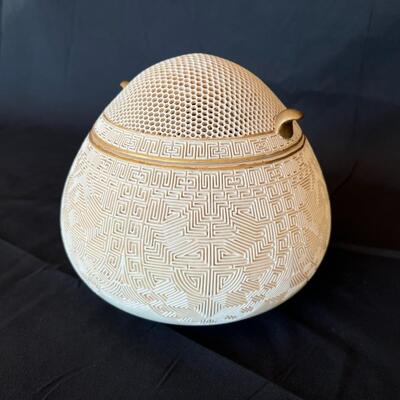
Very rare and extraordinarily intricate design on this Japanese satsuma incense burner. Stamped by maker. Lid features a honeycomb reticulated double wall design (very high levels of craftsmanship). Gilt gold painted on edges of lid and small handles. This piece was evaluated in 1992 by Honeychurch Antiques gallery in Seattle, WA to be very rare piece of extremely fine design, and attributed to the Meiji Period circa 1880. In very good condition. 177 / 901 sold -
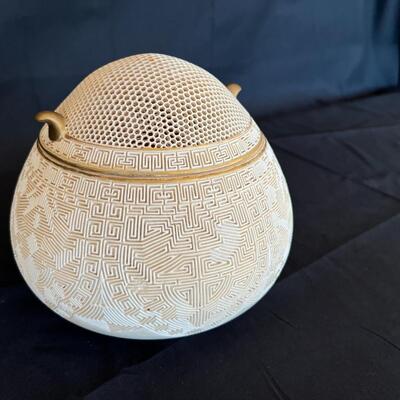
Very rare and extraordinarily intricate design on this Japanese satsuma incense burner. Stamped by maker. Lid features a honeycomb reticulated double wall design (very high levels of craftsmanship). Gilt gold painted on edges of lid and small handles. This piece was evaluated in 1992 by Honeychurch Antiques gallery in Seattle, WA to be very rare piece of extremely fine design, and attributed to the Meiji Period circa 1880. In very good condition. 178 / 901 sold -
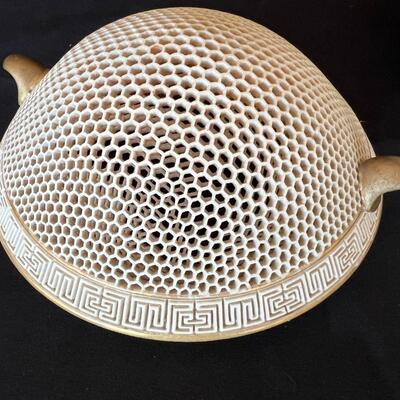
Very rare and extraordinarily intricate design on this Japanese satsuma incense burner. Stamped by maker. Lid features a honeycomb reticulated double wall design (very high levels of craftsmanship). Gilt gold painted on edges of lid and small handles. This piece was evaluated in 1992 by Honeychurch Antiques gallery in Seattle, WA to be very rare piece of extremely fine design, and attributed to the Meiji Period circa 1880. In very good condition. 179 / 901 sold -

Very rare and extraordinarily intricate design on this Japanese satsuma incense burner. Stamped by maker. Lid features a honeycomb reticulated double wall design (very high levels of craftsmanship). Gilt gold painted on edges of lid and small handles. This piece was evaluated in 1992 by Honeychurch Antiques gallery in Seattle, WA to be very rare piece of extremely fine design, and attributed to the Meiji Period circa 1880. In very good condition. 180 / 901 sold -
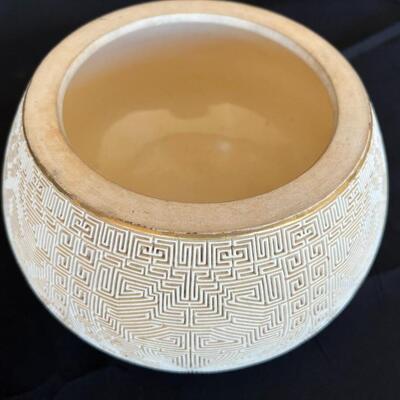
Very rare and extraordinarily intricate design on this Japanese satsuma incense burner. Stamped by maker. Lid features a honeycomb reticulated double wall design (very high levels of craftsmanship). Gilt gold painted on edges of lid and small handles. This piece was evaluated in 1992 by Honeychurch Antiques gallery in Seattle, WA to be very rare piece of extremely fine design, and attributed to the Meiji Period circa 1880. In very good condition. 181 / 901 sold -
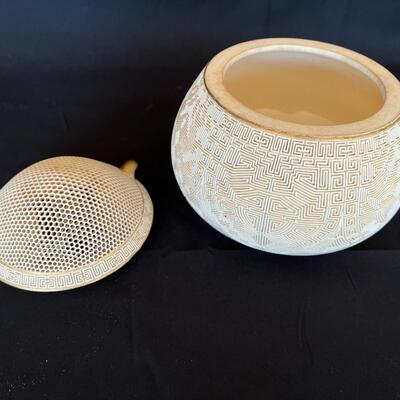
Very rare and extraordinarily intricate design on this Japanese satsuma incense burner. Stamped by maker. Lid features a honeycomb reticulated double wall design (very high levels of craftsmanship). Gilt gold painted on edges of lid and small handles. This piece was evaluated in 1992 by Honeychurch Antiques gallery in Seattle, WA to be very rare piece of extremely fine design, and attributed to the Meiji Period circa 1880. In very good condition. 182 / 901 sold -
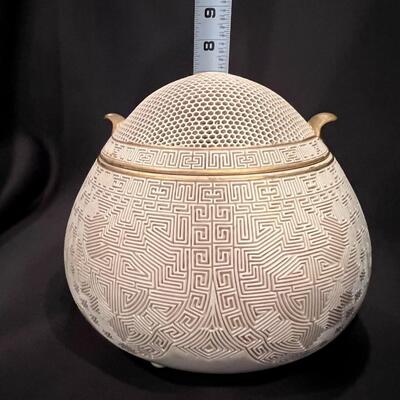
Very rare and extraordinarily intricate design on this Japanese satsuma incense burner. Stamped by maker. Lid features a honeycomb reticulated double wall design (very high levels of craftsmanship). Gilt gold painted on edges of lid and small handles. This piece was evaluated in 1992 by Honeychurch Antiques gallery in Seattle, WA to be very rare piece of extremely fine design, and attributed to the Meiji Period circa 1880. In very good condition. 183 / 901 sold -
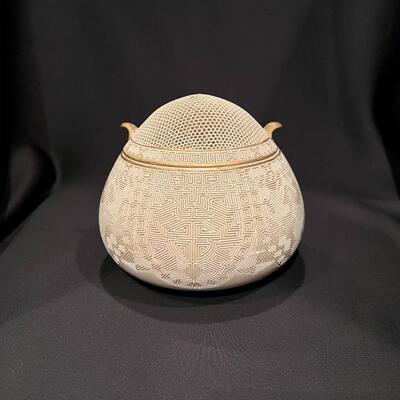
Very rare and extraordinarily intricate design on this Japanese satsuma incense burner. Stamped by maker. Lid features a honeycomb reticulated double wall design (very high levels of craftsmanship). Gilt gold painted on edges of lid and small handles. This piece was evaluated in 1992 by Honeychurch Antiques gallery in Seattle, WA to be very rare piece of extremely fine design, and attributed to the Meiji Period circa 1880. In very good condition. 184 / 901 sold -
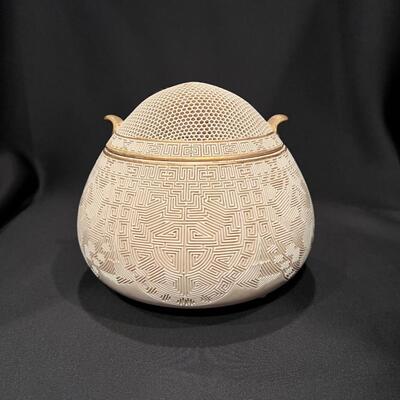
Very rare and extraordinarily intricate design on this Japanese satsuma incense burner. Stamped by maker. Lid features a honeycomb reticulated double wall design (very high levels of craftsmanship). Gilt gold painted on edges of lid and small handles. This piece was evaluated in 1992 by Honeychurch Antiques gallery in Seattle, WA to be very rare piece of extremely fine design, and attributed to the Meiji Period circa 1880. In very good condition. 185 / 901 sold -
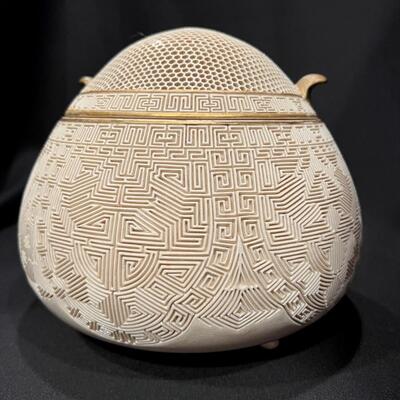
Very rare and extraordinarily intricate design on this Japanese satsuma incense burner. Stamped by maker. Lid features a honeycomb reticulated double wall design (very high levels of craftsmanship). Gilt gold painted on edges of lid and small handles. This piece was evaluated in 1992 by Honeychurch Antiques gallery in Seattle, WA to be very rare piece of extremely fine design, and attributed to the Meiji Period circa 1880. In very good condition. 186 / 901 sold -
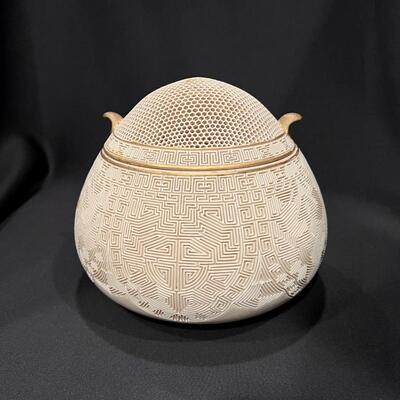
Very rare and extraordinarily intricate design on this Japanese satsuma incense burner. Stamped by maker. Lid features a honeycomb reticulated double wall design (very high levels of craftsmanship). Gilt gold painted on edges of lid and small handles. This piece was evaluated in 1992 by Honeychurch Antiques gallery in Seattle, WA to be very rare piece of extremely fine design, and attributed to the Meiji Period circa 1880. In very good condition. 187 / 901 sold -

Very rare and extraordinarily intricate design on this Japanese satsuma incense burner. Stamped by maker. Lid features a honeycomb reticulated double wall design (very high levels of craftsmanship). Gilt gold painted on edges of lid and small handles. This piece was evaluated in 1992 by Honeychurch Antiques gallery in Seattle, WA to be very rare piece of extremely fine design, and attributed to the Meiji Period circa 1880. In very good condition. 188 / 901 sold -
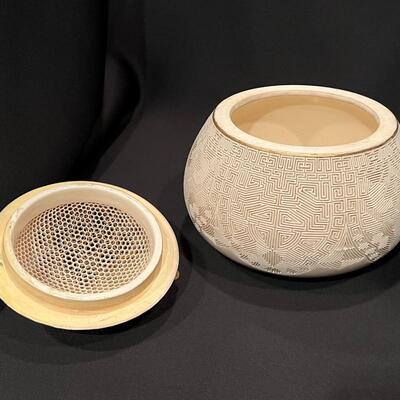
Very rare and extraordinarily intricate design on this Japanese satsuma incense burner. Stamped by maker. Lid features a honeycomb reticulated double wall design (very high levels of craftsmanship). Gilt gold painted on edges of lid and small handles. This piece was evaluated in 1992 by Honeychurch Antiques gallery in Seattle, WA to be very rare piece of extremely fine design, and attributed to the Meiji Period circa 1880. In very good condition. 189 / 901 sold -
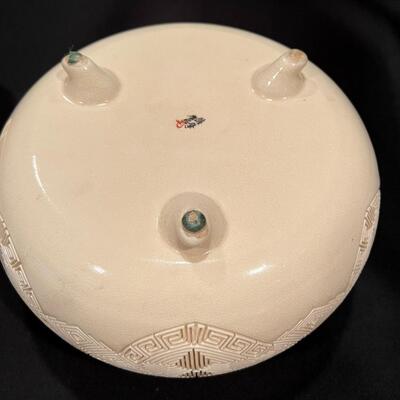
Very rare and extraordinarily intricate design on this Japanese satsuma incense burner. Stamped by maker. Lid features a honeycomb reticulated double wall design (very high levels of craftsmanship). Gilt gold painted on edges of lid and small handles. This piece was evaluated in 1992 by Honeychurch Antiques gallery in Seattle, WA to be very rare piece of extremely fine design, and attributed to the Meiji Period circa 1880. In very good condition. 190 / 901 sold -
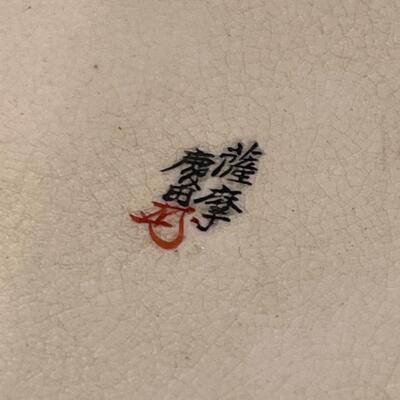
Very rare and extraordinarily intricate design on this Japanese satsuma incense burner. Stamped by maker. Lid features a honeycomb reticulated double wall design (very high levels of craftsmanship). Gilt gold painted on edges of lid and small handles. This piece was evaluated in 1992 by Honeychurch Antiques gallery in Seattle, WA to be very rare piece of extremely fine design, and attributed to the Meiji Period circa 1880. In very good condition. 191 / 901 sold -
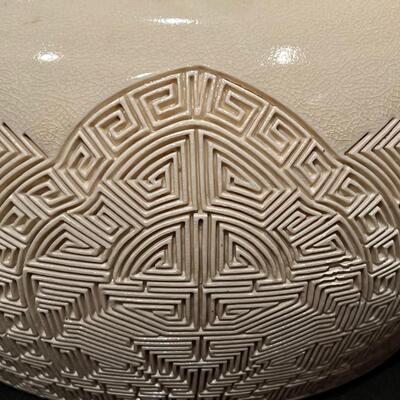
Very rare and extraordinarily intricate design on this Japanese satsuma incense burner. Stamped by maker. Lid features a honeycomb reticulated double wall design (very high levels of craftsmanship). Gilt gold painted on edges of lid and small handles. This piece was evaluated in 1992 by Honeychurch Antiques gallery in Seattle, WA to be very rare piece of extremely fine design, and attributed to the Meiji Period circa 1880. In very good condition. 192 / 901 sold -
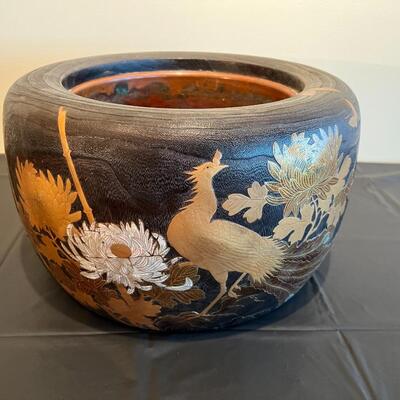
Beautiful antique Japanese Hibachi brazier with wonderful Makie details, and a copper basin. Lacquer and mother-of-pearl inlay design of peacocks and large chrysanthemum flowers, including miniature chrysanthemums known as kokiku. The gold and nashi lacquer is beautiful against the bold grain of the kiri (paulowniia) wood. Provenance from the estate indicates that this piece was acquired in 2003 from the Honeychurch Antiques gallery in Seattle, WA. Condition as shown, exterior is beautiful and copper inside shows signs of erosion. 193 / 901 -
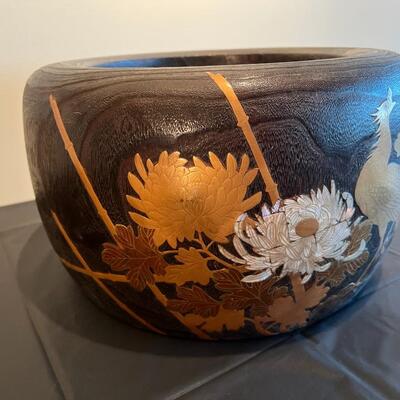
Beautiful antique Japanese Hibachi brazier with wonderful Makie details, and a copper basin. Lacquer and mother-of-pearl inlay design of peacocks and large chrysanthemum flowers, including miniature chrysanthemums known as kokiku. The gold and nashi lacquer is beautiful against the bold grain of the kiri (paulowniia) wood. Provenance from the estate indicates that this piece was acquired in 2003 from the Honeychurch Antiques gallery in Seattle, WA. Condition as shown, exterior is beautiful and copper inside shows signs of erosion. 194 / 901 -

Beautiful antique Japanese Hibachi brazier with wonderful Makie details, and a copper basin. Lacquer and mother-of-pearl inlay design of peacocks and large chrysanthemum flowers, including miniature chrysanthemums known as kokiku. The gold and nashi lacquer is beautiful against the bold grain of the kiri (paulowniia) wood. Provenance from the estate indicates that this piece was acquired in 2003 from the Honeychurch Antiques gallery in Seattle, WA. Condition as shown, exterior is beautiful and copper inside shows signs of erosion. 195 / 901 -
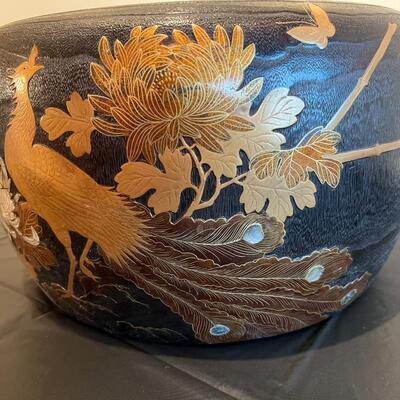
Beautiful antique Japanese Hibachi brazier with wonderful Makie details, and a copper basin. Lacquer and mother-of-pearl inlay design of peacocks and large chrysanthemum flowers, including miniature chrysanthemums known as kokiku. The gold and nashi lacquer is beautiful against the bold grain of the kiri (paulowniia) wood. Provenance from the estate indicates that this piece was acquired in 2003 from the Honeychurch Antiques gallery in Seattle, WA. Condition as shown, exterior is beautiful and copper inside shows signs of erosion. 196 / 901 -
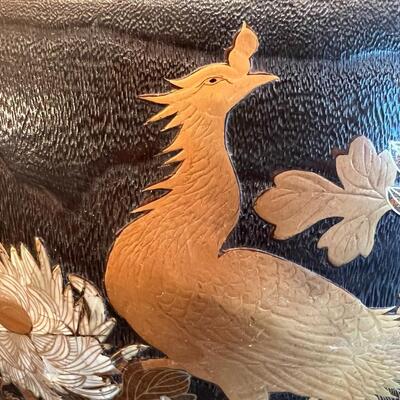
Beautiful antique Japanese Hibachi brazier with wonderful Makie details, and a copper basin. Lacquer and mother-of-pearl inlay design of peacocks and large chrysanthemum flowers, including miniature chrysanthemums known as kokiku. The gold and nashi lacquer is beautiful against the bold grain of the kiri (paulowniia) wood. Provenance from the estate indicates that this piece was acquired in 2003 from the Honeychurch Antiques gallery in Seattle, WA. Condition as shown, exterior is beautiful and copper inside shows signs of erosion. 197 / 901 -
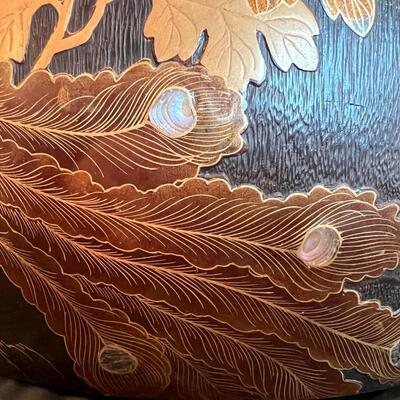
Beautiful antique Japanese Hibachi brazier with wonderful Makie details, and a copper basin. Lacquer and mother-of-pearl inlay design of peacocks and large chrysanthemum flowers, including miniature chrysanthemums known as kokiku. The gold and nashi lacquer is beautiful against the bold grain of the kiri (paulowniia) wood. Provenance from the estate indicates that this piece was acquired in 2003 from the Honeychurch Antiques gallery in Seattle, WA. Condition as shown, exterior is beautiful and copper inside shows signs of erosion. 198 / 901 -
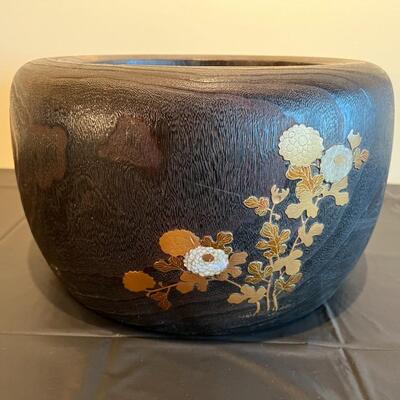
Beautiful antique Japanese Hibachi brazier with wonderful Makie details, and a copper basin. Lacquer and mother-of-pearl inlay design of peacocks and large chrysanthemum flowers, including miniature chrysanthemums known as kokiku. The gold and nashi lacquer is beautiful against the bold grain of the kiri (paulowniia) wood. Provenance from the estate indicates that this piece was acquired in 2003 from the Honeychurch Antiques gallery in Seattle, WA. Condition as shown, exterior is beautiful and copper inside shows signs of erosion. 199 / 901 -
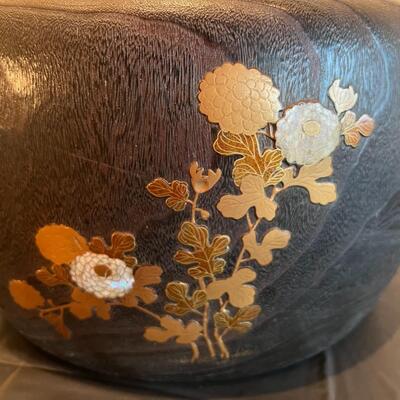
Beautiful antique Japanese Hibachi brazier with wonderful Makie details, and a copper basin. Lacquer and mother-of-pearl inlay design of peacocks and large chrysanthemum flowers, including miniature chrysanthemums known as kokiku. The gold and nashi lacquer is beautiful against the bold grain of the kiri (paulowniia) wood. Provenance from the estate indicates that this piece was acquired in 2003 from the Honeychurch Antiques gallery in Seattle, WA. Condition as shown, exterior is beautiful and copper inside shows signs of erosion. 200 / 901
Photos 101 - 200 of 901
Per page:
